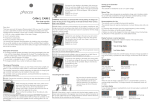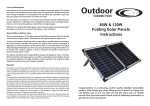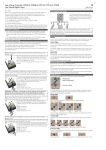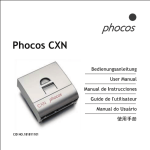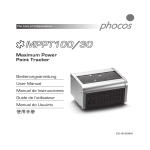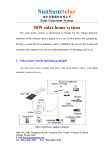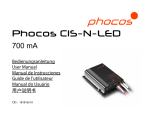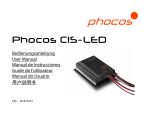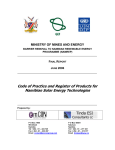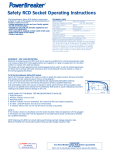Download Phocos CA English User Manual
Transcript
Phocos CA
Solar Charge Controller
User Manual (English)
Dear customer,
Thank you very much for buying
this Phocos product. Please read
the instructions carefully and
thoroughly before using the
product.
14
Your new CA controller is a state-of-the art device which was
developed in accordance with the latest available technical
standards. It comes with a number of outstanding features, such
as:
3 LEDs for a clear, readable display of the state of charge
16 mm2 connector clamps
Temperature compensation
Electronic protection without fuses
Please read this manual carefully taking special note of the safety
and usage recommendations at the end. The manual gives important
recommendations for installing, using and programming as well
as a troubleshooting guide for potential problems with the controller.
Description of Functions
The charge controller protects the battery from being overcharged
by the solar array and from being deeply discharged by the
loads. The charging takes place through multiple stages which
include automatic adaptation to the ambient temperature for
optimal charging of the battery.
The controller is intended for use at 12 V system voltage.
The charge controller has a number of safety and display
functions.
15
Mounting and Connecting
The controller is intended for indoor use only. Protect it from
direct sunlight and place it in a dry environment. Never install it
in humid rooms (like bathrooms). The controller measures the
ambient temperature to determine the charging voltage. Controller
and battery must be installed in the same room.
The controller warms up during operation, and should therefore
be installed on a non flammable surface only.
REMARK: Connect the controller by following the steps described
below to avoid installation faults.
When mounting the controller with
screws, make sure to use screws that
suit the attachment material (use
screws with 4 mm shaft and max. 8
mm head diameter, no counter sink).
Keep in mind that the screws also have
to carry the force applied by the wiring.
Make sure that the ventilator slits on
the sides are unobstructed.
16
A DIN Rail mounting plate is available as an accessory (CX-DR2).
This allows mounting the controller on a standard 35mm DIN rail.
Place the controller on the mounting plate, and use the screws
supplied with the mounting plate to fix it to the controller.
Connect the wires leading to the battery
with correct polarity. To avoid any
voltage on the wires, first connect the
controller, then the battery. Keep in
mind the recommended wire length
(min. 30 to max approx. 100 cm) and
the wire size:
CA06-2.1: min. 2.5mm2
CA08-2.1: min. 4mm2
CA10-2.1: min. 6mm2
CA14-1.1: min. 10mm2
WARNING: If the battery is connected with reverse polarity,
the charge controller will also give the wrong polarity on the
load terminals. Never connect loads in this situation!
REMARK: Keep in mind the recommendations of your battery
manufacturer. We strongly recommend connecting a fuse
directly to the battery to protect any short circuit at the
battery wiring. The fuse type must be in accordance with the
charge controller's nominal current:
CA06, CA08-2.1: 20A; CA10-2.1,CA14-1.1:30A
17
Connect the wires leading to the solar
array with correct polarity. To avoid
any voltage on the wires, first connect
the controller, then the solar array.
Keep in mind the recommended wire
size:
CA06-2.1: min. 2.5mm2
CA08-2.1: min. 4mm2
CA10-2.1: min. 6mm2
CA14-1.1: min. 10mm2
REMARK: place positive and negative wires leading to the solar
generator close to each other to minimize electromagnetic
effects.
REMARK: Solar panels provide voltage as soon as exposed to
sun light. Keep in mind the solar panel manufacturers
recommendations in any case.
Connect the wires leading to the
loads with correct polarity. To avoid
any voltage on the wires, first
connect the wire to the load, then
to the controller. Keep in mind the
recommended wire size:
CA06-2.1: min. 2.5mm2
CA08-2.1: min. 4mm2
CA10-2.1: min. 6mm2
CA14-1.1: min. 10mm2
18
Grounding the Solar System
Be aware that the positive terminals of the controller are connected
internally and therefore have the same electrical potential. If any
grounding is required, always do this on the positive wires.
REMARK: If the device is used in a vehicle which has the battery
negative on the chassis, loads connected to the regulator must
not have an electric connection to the car body. Otherwise the
Low Voltage Disconnect function and the electronic fuse function
of the controller are short circuited.
19
Starting up the Controller
System Voltage
The controller is intended for use at 12V system voltage.
Battery Type
The controller does not generate an equalization charge, and is
therefore suitable for use with lead acid batteries with liquid
electrolyte (vented battery) and lead acid batteries with solid
electrolyte ('gel' or 'fleece' type).
Recommendations for Use
The controller warms up slightly during normal operation.
The controller does not need any maintenance or service. Remove
dust with a dry tissue.
It is important that the battery gets fully charged frequently (at
least monthly).
Otherwise the battery will be permanently damaged.
A battery can only be fully charged if not too much energy is drawn
during charging. Keep that in mind, especially if you install additional
loads.
20
Display Functions in normal operation
The controller is equipped with 3 LEDs for display of the operating
status.
Charge display
Battery voltage display
Load status display
In normal operation mode, the controller displays the charging
status, the status of battery voltage, and the status of the load
output.
Charge display
(green LED off)
Solar array does not
supply electricity
(green LED on)
Solar array does
supply electricity
21
Battery voltage display
OK (LED off)
low (LED on)
very low
(LED flashing)
When the battery voltage is indicated as low, it is recommended
to use the remaining energy economically. The charge controller
will subsequently switch off the load.
Load status display
In case of deep discharge or overload/short-circuit, the load output
is switched off. This is indicated by:
(LED off)
Normal
operation
(LED on)
Low voltage
disconnect
(LED flashing)
Overload or
Short-circuit of load
Low Voltage Disconnect Function (LVD)
The controller is equipped with a low voltage disconnection function
to protect the battery against a deep discharge: This function is
controlled by the voltage, and automatically switches off the load
output at a battery voltage lower than 11.5V. As soon as the battery
reaches a voltage of 12.5V, the load output is switched on again.
22
Safety Features
The controller is protected against improper installation or use:
At the solar
terminal
At the battery
terminal
Unrestricted
Normal operation
Unrestricted
Yes, if only the
battery is connected.
Reverse polarity
Unrestricted
Yes, if only the
battery is
connected.
Load output is
protected, but
loads might be
damaged.
Short circuit
Unrestricted
Unrestricted.
CAUTION: Battery
must be protected
by fuse.
Unrestricted
Overcurrent
No protection
-------
No connection
Unrestricted
Unrestricted
Controller
switches off load.
Unrestricted
Reverse current
Unrestricted
-------
-------
Overvoltage
Varistor 56 V, 2.3 J
Battery connected
with correct
polarity
Battery connected
with wrong polarity
Undervoltage
At the load
terminal
Unrestricted
Unrestricted
Max. 30 V
No protection
Controller switch Controller switches
Normal operation es off load terminal.
off load terminal.
WARNING: The combination of different error conditions may
cause damage to the controller. Always remove an error before
you continue connecting the controller!
23
Error Description
Error
Loads are
not supplied
Display
Reason
Battery is low
(LED on)
Overcurrent/
Short circuit
of loads
(LED flashing)
Recomendation
Load will
reconnect as soon
as battery is
recharged.
Switch off all loads.
Remove short circuit.
Controller will switch
on load automatically
after max 1 minute.
Battery is
empty again
after a short
time
Battery has
low capacity
(LED on)
Change battery
Battery is not
being charged
during the day
Solar array
faulty or
wrong polarity
Remove faulty
connection /
reverse polarity
General Safety and Usage Recommendations
Intended Use
The charge controller is intended exclusively for use in photovoltaic
systems with 12V nominal voltage, and in conjunction with vented
or sealed (VRLA) lead acid batteries only.
24











